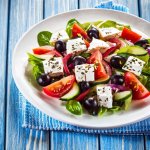dubai_suzie
Active member
This is one of my favorite appetizers to make. All you need to do is add butter to a skillet and heat over medium heat. After the butter is melted, place the halloumi/kefalograviera cheese cubes in the skillet in a single layer and sauté until the bottoms turn brown. This should take about 1 minute. Turn each of the cubes over on all sides and sauté each until they also turn brown. This should take an additional 3 minutes.
Remove the cheese cubes from the skillet using a slotted spoon and drain on absorbent paper towels for 1-2 minutes. Transfer to a serving platter and sprinkle with confectioners’ sugar. Serve immediately.
Remove the cheese cubes from the skillet using a slotted spoon and drain on absorbent paper towels for 1-2 minutes. Transfer to a serving platter and sprinkle with confectioners’ sugar. Serve immediately.



